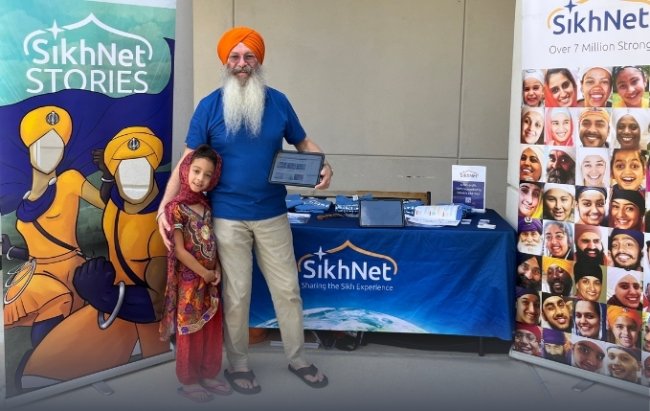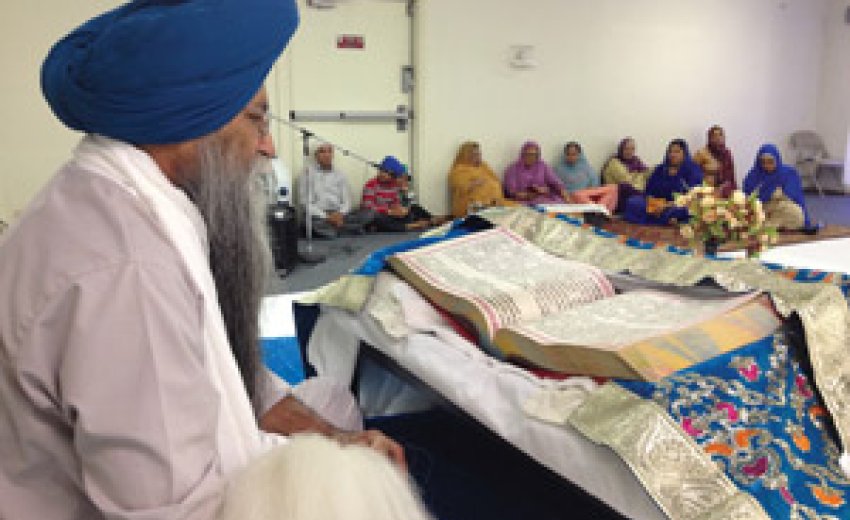Yuba City has long been a hub for East Indian immigrants, and now Chico is home to a temple
 |
| Jasbir Singh oversees religious services at Dashmesh Darbar, Chico’s first Sikh gurdwara, or temple. PHOTO BY KEN SMITH |
On Sunday mornings, while the restaurant’s patrons sip champagne and eat omelets served on red-and-white-checkered tablecloths by costumed waitresses, local Sikhs engage in a more austere and veritable cultural tradition—the diwan, or religious service—just steps away.
Behind the gurdwara’s tinted glass door, an elderly, turbaned man named Jasbir Singh sits cross-legged on a raised platform covered in bright-blue material behind the Guru Granth Sahib, the main holy scripture of Sikhdom, which adherents revere as more than just a book—they see it as a sovereign, active and living Guru. Worshippers remove their shoes and cover their heads before entering the temple, and once inside, place an offering (usually a few dollar bills) before the Guru, push their hands together to pray, then drop to their knees and bow until their foreheads touch the carpeted floor. They then join the rest of the sangat, or congregation, at either side of the room.| Celebrate Sikh culture: The 34th annual Yuba City Sikh Festival and Parade takes place Friday through Sunday, Nov. 1-3, with the parade happening Sunday, Nov. 3 at 11 a.m. The action is centered around the Yuba City Sikh Temple at 2468 Tierra Buena Road. Go to www.tinyurl.com/SikhFest for more information. An exhibit on Sikh history in the North State is on permanent display at the Community Memorial Museum at 1333 Butte House Road in Yuba City. Call 822-7141 for hours. The curators also maintain a very informative website at www.punjabipioneers.com. |
For two hours, those present shared in the duty of leading sacred chants in Punjabi, taking turns singing out alone as the rest sang responses in chorus. At one point, two of the women in attendance produced a harmonium (small pump organ) and a tabla (drum), to accompany the group in the singing of devotional hymns. At the end, Singh circled the room, smiling as he handed out the karah parshad, a sweet sacramental food that tastes something like cookie dough.
Though the diwan may seem exotic and strange to those unfamiliar with Sikhism or Indian customs, it’s actually something that’s been happening regularly in the North State for more than 100 years. Beginning in 1903, thousands of Indian immigrants—mostly Sikh, but also some Hindu and Muslim—came to Northern California to work. Some helped build railroads, while many worked on farms as their ancestors in the Punjab region of India had done for centuries.
Many stayed in the fertile Sacramento Valley, and today, Yuba City—where all three area high schools teach Punjabi as a second language, and fresh samosas are as readily available as cheeseburgers or burritos—is home to one of the largest Sikh populations outside of India. More continue to arrive, joining American Sikhs of Punjabi ancestry who can trace their local heritage back further than many WASPS (White Anglo-Saxon Protestants) and adding to the racial and spiritual diversity of Northern California.
 |
| Kashmir Gill became the first Sikh mayor in the U.S. in 2009. PHOTO BY PHOTO COURTESY OF KASHMIR GILL |
“There is only one God,” Singh, the gurdwara’s granthi — or caretaker—offered in a thick Punjabi accent, holding up his index finger for emphasis, when asked about the basics of Sikhism. He paused, smiled behind his long and immaculately maintained facial hair and shook the finger as he added, “Too many names,” indicating the Sikh belief that all of the world’s deities are one. To illustrate further, he took a poster from the wall with symbols from many of the world’s religions arranged in a wheel, all radiating from a central point representing enlightenment.
Sikhism is the fifth largest religion in the world, with about 30 million adherents. It is monotheistic and, despite some perceived similarities to Christianity and Islam, as well as an open and accepting attitude toward other religions, is entirely its own philosophy.
The religion was founded by Guru Nanak—the first of 10 Gurus—in the 15th century. Sikhs believe that secular and spiritual life are intertwined, and the best way to know God in one’s heart is by living a good life. Guru Nanak taught that Sikhs should work hard to make a living, without begging or being deceitful, and also to share the fruits of these labors with the less fortunate. Sikhs are encouraged to participate in acts of selfless service, called seva. Sikhism’s guiding principles are truth, equality, freedom and justice.
Sikhs believe all people—regardless of race, sex or creed—are equal. Since Guru Nanak’s day, they have denounced the caste system, with many Sikhs disregarding their family names and the ranks they imply, instead adopting the last names Singh (meaning lion) for men or Kaur (princess) for women.
As Chico Sikh Surinder Bhandal explained, the langar embodies many Sikh ideals. “It shows that we are all one,” she explained as everyone present shared a vegetarian meal of spicy chickpeas, long-grain rice, sweet yogurt, cheese curds and delicious homemade naan. “There are no classes or castes, no differences between men and women, and different religions do not matter. We are all equal.”
In urban areas, Sikhs often take the langar out of the temple and into the streets to help the homeless and other underserved communities. A group of mostly 20-something Sikhs working under the name SEVA: Selfless Service, for example, organizes weekly free meals, primarily in downtown Sacramento and San Francisco. They serve everything from traditional Indian dishes to vegetarian pizzas and, on one recent outing in Yuba City, peanut-butter-and-jelly sandwiches made by elementary-school-age Sikhs who raised $80 to buy all of the ingredients.
Singh came to Yuba City from the Indian state of Punjab in 2005, but stayed there only two days before moving to Chico to work in a Sikh-owned gas station. Feeling it was too much of a strain—especially for elderly Sikhs—to travel to Yuba City once or more weekly, he saved money and obtained the necessary permits to open Chico’s first gurdwara last January.
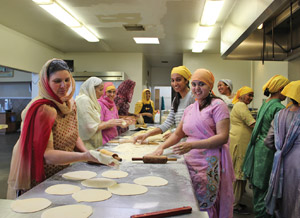 |
| A number of women help prepare food at Yuba City’s largest gurdwara on Tierra Buena Road, the epicenter of the city’s three-day Sikh festival and parade. PHOTO BY KEN SMITH |
In addition to the Sunday diwan, other services are held throughout the week at the gurdwara. Singh also hosts Punjabi classes for young Sikhs to help them connect with their heritage.
Singh, with his distinctive facial coiffure, is what is known as a baptized Sikh, one who has “taken amrit,” or undergone a special ceremony involving anointment with holy water. In order for Sikhs to be baptized, they must dedicate themselves to living life as laid out by the Gurus, remain vegetarian, and always carry five articles of faith, known as the “five K’s.”
The five K’s are Kesh (long, uncut hair), Kangha (a small wooden comb for maintaining the Kesh), Kara (a metal bracelet), Kacherra (an undergarment) and Kirpan (a small sword or dagger).
The majority of modern Sikhs are not baptized and thus do not maintain the five K’s. The most common “K” maintained by many Sikhs, even those who are not practicing or actively engaged in their religion and are Sikh only by heritage, is the Kara. Also, Kirpans have evolved from the original long, curved sword to take forms that make it easier to get by in modern society, where the carrying of swords can cause obvious trouble. Some Sikhs simply wear a Kirpan-shaped charm on a necklace.
The history of Sikhs in America, like that of many minorities, has not always been one of openness and acceptance. Beginning in the 1920s and for much of the next four decades, Sikhs were subject to anti-Asian immigration laws that for many years stemmed the migration of Sikhs to the United States altogether, and naturalized Sikhs were barred from owning land or exercising some rights enjoyed by other American citizens. As these laws were loosened or abolished in the 1950s and ’60s, the United States saw large influxes of Sikhs.
They have also been persecuted in other countries, including India, where Sikhism was born in the Punjab region. Throughout their 500-year history, Sikhs have been forced to fight to protect their way of life.
Throughout the 1970s, efforts by Punjabi Sikhs to obtain autonomy were met with armed responses and arrests by the Indian government, then led by Indira Gandhi. This escalated until 1984, when Indian forces surrounded one of Sikhdom’s most holy sites, the Harmandir Sahib (or Golden Temple) in the city of Amritsar, India, killing hundreds. In response, two of Gandhi’s Sikh bodyguards assassinated her on Oct. 31, 1984. This led to anti-Sikh riots and attacks that killed an estimated 8,000 Sikhs and displaced a great deal more.
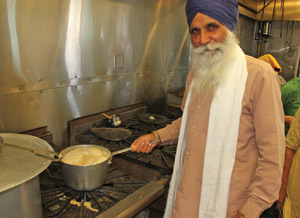 |
| Harbhajan Singh working in the kitchen of the Yuba City gurdwara. PHOTO BY KEN SMITH |
Last year, Wade Michael Page, a white supremacist and U.S. Army veteran, entered a Sikh gurdwara in Oak Creek, Wis., and opened fire with a 9 mm handgun. He killed six Sikhs—five men and one woman, ages 39 to 84.
Just last month, two high-profile examples of Sikh persecution made headlines. Prabhjot Singh, a doctor and Columbia University professor, was beaten near New York City’s Central Park on Sept. 21 by 25 to 30 men who yelled, “Get him! Osama!” The professor underwent surgery to his jaw as a result of the attack.
Also in September, the American Civil Liberties Union announced it was representing Jagjeet Singh, a California truck driver who was pulled over for a flat tire last January in Mississippi, and arrested by officers from the state’s Department of Transportation for refusing to turn over his three-inch Kirpan. During the arrest, the officers allegedly remarked that “all Sikhs” are “despicable” and “terrorists.” When he appeared in court two months later, a judge demanded he “remove that rag” from his head.
The victim of the New York attack responded in a way that shocked many; in an op-ed piece penned for the New York Daily News and published by other news outlets, he forgave his attackers, inviting them to come to the temple he attends and learn about the Sikh faith, and expressed hope that his attack would open up conversations about prejudice and what it means to be an American.
Every year, during the first weekend of November, between 60,000 and 100,000 people—the overwhelming majority of them Sikh—converge in Yuba City for a three-day festival celebrating the 1699 inauguration of the Guru Granth Sahib. They come from all over the United States—some even from overseas—to celebrate and participate in Sunday’s Nagar Kirtan, a parade that arguably qualifies as the largest religious procession in the United States, and definitely as the city’s largest civic event. This upcoming event marks the festival’s 34th year.
The epicenter of this event is the Sikh Temple Yuba City on Tierra Buena Road, the largest of the city’s three Sikh temples, the onion-shaped top of which rises above the surrounding orchards. There are fireworks on Friday evening, and a weekend-long open-air marketplace at which vendors sell everything from kirpans to Bollywood DVDs and novelty T-shirts reading “Proud to be Punjabi” or “Supersikh” written like the Superman logo. The parade is the largest event, complete with floats, music, dancing, religious chants, and a helicopter dropping rose petals on the crowd.
One thing not for sale is food or drink of any sort. It is provided—in fantastic abundance—for free. An estimated 400,000 meals are given away over the course of the weekend. During a recent visit to the temple on a weekday afternoon nearly a month before the festival, the interior was abuzz with preparation. As a group of men and women engaged in 48 straight hours of reading holy scripture, broadcast throughout the building, more than a dozen men and women worked in the kitchen, doing early preparation of the festival’s food.
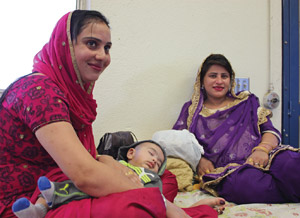 |
| Amardeep Kaloty (left), Ranir Kaur and baby Tarnpreet Bhele taking a break in the Yuba City temple’s kitchen. PHOTO BY KEN SMITH |
In 2009, Gill was sworn in as mayor, giving him the distinction of being the United States’ first Sikh mayor, first mayor of Punjabi descent, and among the first people of Indian origin to hold such a position nationwide. He is currently a City Council member and will assume the mayoral position again in December (in Yuba City, the top two vote-getters in City Council elections both take a one-year turn as mayor). There is currently another Sikh serving on the council, as well—Tej Maan.
“It was interesting, and very humbling,” Gill, who goes by the nickname Kash, said of becoming mayor during a recent interview in his office at Mechanics Bank, where he serves as vice president and senior relationship manager. He also graduated from Chico State University with a degree in agricultural science, and owns a farm in the area.
“We had reporters from Canada, India, London, all the major U.S. networks,” he said, referring to his 2009 inauguration.
Gill has lived in Yuba City most of his life, having arrived with his parents from Lakhsina village in the Hoshiarpur district of Punjab in 1967, at age 2. His family’s history in the area dates back even further, to the first wave of Punjabi immigrants in the early 1900s. His parents were sponsored by his uncle, Didar Singh Bains, a locally famous farmer who at one time produced more peaches than anyone else in the world (“He owned orchards from Chico all the way to Bakersfield,” Gill said).
Gill offered plenty of perspective on his faith, the history of Sikhs in the region, and the community he serves.
“Yuba City was an early hub [of Punjabi migration],” he explained, saying other large enclaves of Sikhs include the Bay Area and New York City. “Everyone has gone out, but it’s like a tree, and all of the roots of the tree are here. You can talk to Sikhs around the United States and ask them who they’re related to, and it all comes back here, because it pretty much originated with 10 families that came here.
“And of course it’s known as a very important agricultural area,” he continued. “Many Sikhs here are doctors and lawyers and professionals, but agriculture is still very important.”
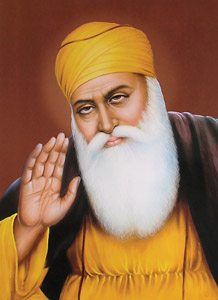 |
| Guru Nanak, born in 1469, founded Sikhism, and is the first of the religion’s 10 gurus. PHOTO BY KEN SMITH |
Remembering more of his childhood, Gill continued: “Before the local temple got built in 1969, the closest one was in Stockton, so we’d all go on the weekends; two families would pile into one car and we’d drive for what seemed like all day. Sometimes we’d spend the whole weekend there, basically camping out at the temple. As a kid, it was great to go to temple and worship, but it also had a railroad line right out back and we’d go play with all the other children by the tracks.”
Still, Gill’s childhood memories aren’t all as halcyon.
“Back then, people called us all ‘Hindus,’ and they didn’t mean it in any sort of positive way,” he said. “Then, after the Golden Temple attack in 1984, people started recognizing that we were Sikhs, and understanding a bit more about East Indians, and Indian Americans, in general.”
Gill keeps his hair cut short and he wears only one of the five K’s, a silver kara on his right wrist, though he explained this doesn’t mean he’s not devout.
“I go to the temple all the time, and recite the prayers,” he explained. “In my eyes, I’m worshiping God. If people want to be fully baptized, that’s the commitment they make at that point in their lives. Maybe someday I’ll be there as well, but right now I’m not quite there.”
Gill said his impetus to get involved in politics was an underrepresentation not only of Sikhs, but also of the entire Indian-American community. He emphasized the importance of education in helping younger Sikhs remember their heritage, as well as educating other cultures about who Sikhs are and what they believe, in order to lessen prejudice.
“There are people who will embrace not just Sikhism, but any culture and anyone,” Gill said. “But there are also always those people who don’t care to learn, don’t care to listen; they don’t care about anything else. It’s not just Sikhism, or any other specific issue that they have a problem with—it’s how they feel about everything.
“People need the education to understand, and what they need to realize is, what it all comes down to is we’re all Americans.”
